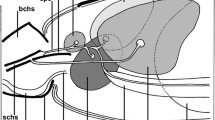Abstract
The microanatomic arrangement of the muscular, nervous, and excretory systems as well as the organization of the tegument are described for the rostellum ofHymenolepis diminuta. An inner circular and an outer longitudinal layer of muscle comprise the rostellar capsule, delimiting the rostellum from the scolex proper. A similar muscular arrangement surrounds an apical invagination of the rostellar tegument, the anterior canal. Elements of the excretory and nervous systems enter the rostellum basally through a discontinuous region of the capsule. Although excretory canals extend into the rostellum, flame cells and their associated collecting ducts are absent. The rostellar nervous system is comprised of a single bilateral pair of ganglia, which provide motor innervation of the anterior canal, and the circular muscles of the rostellar capsule; it also receives dendrites from apical uniciliate sensory receptors. The tegument lining the anterior canal and covering the apical rostellum is syncytial and continuous with the tegument of the scolex proper. Twelve to 15 cytons are radially arranged around the anterior canal. They stain selectively with paraldehyde-fuchsin between days 3 and 35 postinfection, but are clearly tegumental, not neurosecretory elements. The appearance of ovoid granules in the rostellar tegumentary cytons coincides with the onset of fuchsinophilia, but the granules persist despite the subsequent loss of this staining characteristic. Intact granules are secreted into the lumen of the anterior canal, although their function has not been ascertained.
Similar content being viewed by others
References
Andersen, K.: Ultrastructural studies onDiphyllobothrium ditremum andD. dendriticum (Cestoda, Pseudophyllidea), with emphasis on the scolex tegument and the tegument in the area around the genital atrium. Z. Parasitenkd.46, 253–264 (1975)
Cameron, M.L., Steele, J.E.: Simplified aldehyde-fuchsin staining of neurosecretory cells. Stain Technol.34, 265–266 (1959)
Cooper, N.B., Allison, V.F., Ubelaker, J.E.: The fine structure of the cysticercoid ofHymenolepis diminuta. III. The scolex. Z. Parasitenkd.46, 229–239 (1975)
Coutelen, F., Biquet, J., Doby, J.M., Deblock, S.: Le système musculaire du scolex échinococcique. Ann. Parasitol. Hum. Comp.27, 86–94 (1952)
Davey, K.G., Breckenridge, W.R.: Neurosecretory cells in a cestode,Hymenolepis diminuta. Science158, 931–932 (1967)
Ewen, A.B.: An improved aldehyde-fuchsin staining technique for neurosecretory products in insects. Trans. Am. Microsc. Soc.81, 94–96 (1962)
Farooqi, H.U.: The occurrence of certain specialized glands in the rostellum ofTaenia solium L. Z. Parasitenkd.18, 308–311 (1958)
Fioravanti, C.F., MacInnis, A.J.: The in vitro effects of farnesol and derivatives onHymenolepis diminuta. J. Parasitol.62, 749–755 (1976)
Hart, J.L.: Studies on the nervous system of tetrathyridia (Cestoda: Mesocestoides). J. Parasitol.53, 1032–1039 (1967)
Hayat, M.A.: Basic electron microscopic techniques. New York: Van Nostrand Reinhold Company 1972
Hayunga, E.G.: The structure and function of the glands of three caryophyllid tapeworms. Proc. Helminthol. Soc. Wash.46, 171–179 (1979)
Kwa, B.H.: Studies in the sparganum ofSpirometra erinacei. I. The histology and histochemistry of the scolex. Int. J. Parasitol.2, 23–28 (1972)
Lee, M.B., Bueding, E., Schiller, E.L.: The occurrence and distribution of 5-hydroxytryptamine inHymenolepis diminuta andH. nana. J. Parasitol.64, 257–264 (1978)
Öhman-James, C.: Cytology and cytochemistry of the scolex gland cells inDiphyllobothrium ditremum (Creplin, 1825). Z. Parasitenkd.42, 77–86 (1973)
Rawson, D., Rigby, J.E.: The functional anatomy of the cysticercoid ofChoanotaenia crassiscolex (Linstow, 1890) (Dilepididae) from the digestive gland ofOxychilus cellarius (Müll) (Stylommatophora), with some observations on developmental stages. Parasitology50, 453–468 (1960)
Reynolds, E.S.: The use of lead citrate at high pH as an electron-opaque stain in electron microscopy. J. Cell Biol.17, 208 (1963)
Read, C.P., Rothman, A., Simmons, J.E.: Studies on membrane transport, with special reference to host-parasite integration. Ann. NY Acad. Sci.113, 154–205 (1963)
Rees, G.: The anatomy ofCysticercus taeniae-taeniaeformis (Batsch, 1786) (Cysticercus fasciolaris Rud., 1808), from the liver ofRattus norvegicus (Erx.,), including an account of spiral torsion in the species and some minor abnormalities in structure. Parasitology41, 46–59 (1951)
Rothman, A.H.: Studies on the excystment of tapeworms. Exp. Parasitol.8, 336–364 (1959)
Smyth, J.D.: Observations on the scolex ofEchinococcus granulosus with special reference to the occurrence and cytochemistry of secretory cells in the rostellum. Parasitology54, 515–526 (1964)
Smyth, J.D.: The physiology of cestodes. San Francisco: W. H. Freeman 1969
Smyth, J.D., Miller, H.J., Howkins, A.B.: Further analysis of the factors controlling strobilization, differentiation and maturation ofEchinococcus granulosus in vitro. Exp. Parasitol.21, 31–41 (1967)
Steel, C.G.H., Morris, G.P.: A simple technique for selective staining of neurosecretory products in epoxy sections with paraldehyde fuchsin. Can. J. Zool.55, 1571–1575 (1977)
Tofts, J., Meerovitch, E.: The effect of farnesyl methyl ether, a mimic of insect juvenile hormone, onHymenolepis diminuta in vitro. Int. J. Parasitol.4, 211–218 (1974)
Tower, W.L.: The nervous system of the cestode,Moniezia expansa. Zool. Jahrb. Abt. Allg. Zool. Physiol. Tiere13, 359–381 (1900)
Wardle, R., McLeod, J.A.: The zoology of tapeworms. Minneapolis: University of Minnesota Press 1952
Webb, R.A., Davey, K.G.: The gross anatomy and histology of the nervous system of the metacestode ofHymenolepis microstoma. Can. J. Zool.53, 661–667 (1975)
Webb, R.A., Davey, K.G.: The fine structure of the nervous tissue of the metacestode ofHymenolepis microstoma. Can. J. Zool.54, 1206–1222 (1976)
Wilson, V.C.L.C., Schiller, E.L.: The neuroanatomy ofHymenolepis diminuta andH. nana. J. Parasitol.55, 261–270 (1969)
Author information
Authors and Affiliations
Rights and permissions
About this article
Cite this article
Specian, R.D., Lumsden, R.D. The microanatomy and fine structure of the rostellum ofHymenolepis diminuta . Z. Parasitenkd. 63, 71–88 (1980). https://doi.org/10.1007/BF00927728
Received:
Issue Date:
DOI: https://doi.org/10.1007/BF00927728




